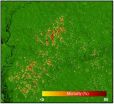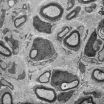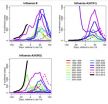(Press-News.org) ROCHESTER, Minn. -- Cardiac disease is associated with increased risk of mild cognitive impairment such as problems with language, thinking and judgment -- particularly among women with heart disease, a Mayo Clinic study shows. Known as nonamnestic because it doesn't include memory loss, this type of mild cognitive impairment may be a precursor to vascular and other non-Alzheimer's dementias, according to the findings published online Monday in JAMA Neurology.
Mild cognitive impairment is an important stage for early detection and intervention in dementia, says lead author, Rosebud Roberts, M.B., Ch.B., a health sciences researcher at Mayo Clinic.
"Prevention and management of cardiac disease and vascular risk factors are likely to reduce the risk," Roberts says.
Researchers evaluated 2,719 people ages 70 to 89 at the beginning of the study and every 15 months after. Of the 1,450 without mild cognitive impairment at the beginning, 669 had heart disease and 59 (8.8 percent) developed nonamenestic mild cognitive impairment; in comparison 34 (4.4 percent) of 781 who did not have heart disease developed nonamenestic mild cognitive impairment.
The association varied by sex; cardiac disease and mild cognitive impairment appeared together more often among women than in men.
### This research was funded by National Institutes of Health grant AG006786 and the Robert H. and Clarice Smith and Abigail van Buren Alzheimer's Disease Research Program and was made possible by the NIH-funded Rochester Epidemiology Project.
About Mayo Clinic
Mayo Clinic is a nonprofit worldwide leader in medical care, research and education for people from all walks of life. For more information, visit www.mayoclinic.com and www.mayoclinic.org/news.
Journalists can become a member of the Mayo Clinic News Network for the latest health, science and research news and access to video, audio, text and graphic elements that can be downloaded or embedded.
Cardiac disease linked to higher risk of mental impairment, Mayo Clinic finds
2013-01-29
ELSE PRESS RELEASES FROM THIS DATE:
New research will help shed light on role of Amazon forests in global carbon cycle
2013-01-29
The Earth's forests perform a well-known service to the planet, absorbing a great deal of the carbon dioxide pollution emitted into the atmosphere from human activities. But when trees are killed by natural disturbances, such as fire, drought or wind, their decay also releases carbon back into the atmosphere, making it critical to quantify tree mortality in order to understand the role of forests in the global climate system. Tropical old-growth forests may play a large role in this absorption service, yet tree mortality patterns for these forests are not well understood. ...
The tales teeth tell
2013-01-29
For more than two decades, scientists have relied on studies that linked juvenile primate tooth development with their weaning as a rough proxy for understanding similar developmental landmarks in the evolution of early humans. New research from Harvard, however, is challenging those conclusions by showing that tooth development and weaning aren't as closely related as previously thought.
Using a first-of-its-kind method, a team of researchers led by professors Tanya Smith and Richard Wrangham and Postdoctoral Fellow Zarin Machanda of Harvard's Department of Human Evolutionary ...
Glial cells assist in the repair of injured nerves
2013-01-29
This press release is available in German.
Unlike the brain and spinal cord, the peripheral nervous system has an astonishing capacity for regeneration following injury. Researchers at the Max Planck Institute of Experimental Medicine in Göttingen have discovered that, following nerve damage, peripheral glial cells produce the growth factor neuregulin1, which makes an important contribution to the regeneration of damaged nerves.
From their cell bodies to their terminals in muscle or skin, neuronal extensions or axons in the peripheral nervous system are surrounded ...
EARTH: Drinking toilet water
2013-01-29
Alexandria, VA – Would you drink water from a toilet? What if that water, once treated, was cleaner than what comes out of the faucet? Although the imagery isn't appealing, as climate change and population growth strain freshwater resources, such strategies are becoming more common around the world — and in the United States.
Over the last several decades, local and regional water shortages have become increasingly common. These shortages have led to increased friction over water resources. Technologies are currently being developed to help make wastewater recycling ...
1 in, 2 out: Simulating more efficient solar cells
2013-01-29
Using an exotic form of silicon could substantially improve the efficiency of solar cells, according to computer simulations by researchers at the University of California, Davis, and in Hungary. The work was published Jan. 25 in the journal Physical Review Letters.
Solar cells are based on the photoelectric effect: a photon, or particle of light, hits a silicon crystal and generates a negatively charged electron and a positively charged hole. Collecting those electron-hole pairs generates electric current.
Conventional solar cells generate one electron-hole pair ...
Study finds eating deep-fried food is associated with an increased risk of prostate cancer
2013-01-29
SEATTLE – Regular consumption of deep-fried foods such as French fries, fried chicken and doughnuts is associated with an increased risk of prostate cancer, and the effect appears to be slightly stronger with regard to more aggressive forms of the disease, according to a study by investigators at Fred Hutchinson Cancer Research Center.
Corresponding author Janet L. Stanford, Ph.D., and colleagues Marni Stott-Miller, Ph.D., a postdoctoral research fellow and Marian Neuhouser, Ph.D., all of the Hutchinson Center's Public Health Sciences Division, have published their findings ...
Study shows climate change could affect onset and severity of flu seasons
2013-01-29
The American public can expect to add earlier and more severe flu seasons to the fallout from climate change, according to a research study published online Jan. 28 in PLOS Currents: Influenza.
A team of scientists led by Sherry Towers, research professor in the Mathematical, Computational and Modeling Sciences Center at Arizona State University, studied waves of influenza and climate patterns in the U.S. from the 1997-1998 season to the present.
The team's analysis, which used Centers for Disease Control data, indicates a pattern for both A and B strains: warm winters ...
Research: Military women may have higher risk for STIs
2013-01-29
As the number of women in the military increases, so does the need for improved gynecologic care. Military women may be more likely to engage in high-risk sexual practices, be less likely to consistently use barrier contraception, and, therefore, more likely to contract sexually transmitted infections (STIs), according to research recently released by a physician at Women & Infants Hospital of Rhode Island.
Vinita Goyal, MD, MPH, followed up earlier research into the rates of contraception use and unintended pregnancy by today's military women and veterans with her latest ...
USGS-NOAA: Climate change impacts to US coasts threaten public health, safety and economy
2013-01-29
According to a new technical report, the effects of climate change will continue to threaten the health and vitality of U.S. coastal communities' social, economic and natural systems.
The report, Coastal Impacts, Adaptation, and Vulnerabilities: a technical input to the 2013 National Climate Assessment, authored by leading scientists and experts, emphasizes the need for increased coordination and planning to ensure U.S. coastal communities are resilient against the effects of climate change.
The recently released report examines and describes climate change impacts ...
When food porn holds no allure: The science behind satiety
2013-01-29
New research from the University of British Columbia is shedding light on why enticing pictures of food affect us less when we're full.
"We've known that insulin plays a role in telling us we're satiated after eating, but the mechanism by which this happens is unclear," says Stephanie Borgland, an assistant professor in UBC's Dept. of Anesthesiology, Pharmacology and Therapeutics and the study's senior author.
In the new study published online this week in Nature Neuroscience, Borgland and colleagues found that insulin – prompted by a sweetened, high-fat meal – affects ...



